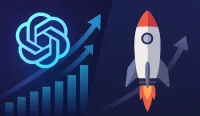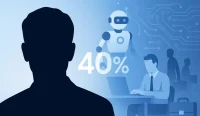Godfather of AI warns “You have no idea what’s coming” as the rapid advancement toward superintelligence threatens to fundamentally reshape the job market and create unprecedented challenges for workers across every industry. This stark warning from one of the most respected figures in artificial intelligence research signals a critical moment for job seekers to prepare for a future where human intelligence may become obsolete in most professional domains.
The warning comes from Geoffrey Hinton, often called the “Godfather of AI” for his pioneering work in neural networks and deep learning. His concerns about the pace of AI development and its potential to replace human workers represent more than just academic speculation—they reflect the reality that many jobs as we know them today may cease to exist within the next decade or two.
This development represents a fundamental shift in how we must think about career planning and professional development. The traditional model of building a career in a specific field and expecting it to remain stable for decades is being challenged by AI systems that can perform increasingly complex tasks with superhuman efficiency.
For job seekers, this warning creates both urgency and opportunity. While many traditional jobs may disappear, new opportunities will emerge for those who can adapt and work alongside AI systems rather than compete against them. The key is to understand which skills will remain valuable and which careers offer the best protection against AI displacement.
The Superintelligence Timeline: 10-20 Years to Job Displacement
Hinton’s warning is particularly concerning because of his timeline predictions. He estimates that superintelligence—AI systems that are better than humans at virtually everything—could arrive within 10-20 years, potentially even sooner. This compressed timeline means that the job market disruption could happen much faster than most people are prepared for.
The superintelligence timeline is significant because it represents a fundamental break from previous technological revolutions. While past innovations like the industrial revolution replaced human physical labor, AI is targeting intellectual labor—the very foundation of most modern careers.
This timeline creates a sense of urgency for job seekers who need to start preparing now for a future where their current skills may become obsolete. The window for adaptation is relatively short, making it crucial to begin developing AI-resistant skills and exploring career paths that are less likely to be automated.
The superintelligence timeline also highlights the importance of continuous learning and skill development. In a world where AI capabilities are advancing rapidly, the ability to adapt and learn new skills quickly becomes one of the most valuable human capabilities.
For job seekers, this means:
- Starting to develop AI-resistant skills immediately
- Focusing on careers that require human creativity and emotional intelligence
- Building expertise in areas where human judgment is irreplaceable
- Learning to work effectively with AI systems rather than against them
- Developing skills that complement rather than compete with AI capabilities
The Job Displacement Reality: From 5x Efficiency to Mass Unemployment
Hinton’s warning about job displacement is based on a simple but powerful observation: AI systems can make individual workers dramatically more efficient, but this efficiency often leads to fewer jobs rather than more. His example of his niece’s work illustrates this perfectly—what used to take 25 minutes now takes 5 minutes, meaning she can do the work of five people.
This efficiency multiplier effect is particularly concerning because it applies to most intellectual work. When AI can make a single worker five times more efficient, companies need five times fewer workers to accomplish the same amount of work.
The job displacement reality is different from previous technological revolutions because AI can perform a much wider range of tasks than previous automation technologies. While industrial machines could replace specific physical tasks, AI systems can replace entire categories of intellectual work.
This creates a fundamental challenge for job seekers: how to build careers in a world where most intellectual work can be performed more efficiently by AI systems. The solution is not to avoid AI but to learn how to work with it in ways that create unique value.
The job displacement reality also highlights the importance of choosing careers that are less susceptible to AI automation. Some jobs, like plumbing and other physical trades, may remain relatively safe for longer periods because they require physical manipulation skills that AI systems haven’t yet mastered.
The Wealth Inequality Crisis: Winners and Losers in the AI Economy
Hinton’s warning extends beyond job displacement to the broader economic implications of AI advancement. He predicts that AI will dramatically increase the gap between rich and poor, creating a society where a small elite controls the AI systems while the majority of people struggle to find meaningful work.
This wealth inequality crisis is particularly concerning because it could lead to social instability and political unrest. When large numbers of people are displaced from their jobs and unable to find new ones, societies can become increasingly divided and unstable.
The wealth inequality crisis also highlights the importance of policy responses to AI advancement. Without proper regulation and social safety nets, the benefits of AI could be concentrated in the hands of a few while the costs are borne by many.
For job seekers, this creates additional urgency to position themselves on the winning side of the AI economy. This means developing skills that are complementary to AI systems and building expertise in areas where human judgment and creativity remain valuable.
The wealth inequality crisis also underscores the importance of financial planning and career diversification. In a world where job security is uncertain, having multiple income streams and adaptable skills becomes increasingly important.
The Future of AI Is Uncertain
As the Godfather of AI warns of seismic changes ahead, one thing is clear: the demand for adaptable, future-ready talent is rising fast. Employers must act now to secure professionals who can navigate disruption and drive innovation. Post your job on WhatJobs today and connect with candidates prepared for the AI-powered future.
Post a Job Free for 30 Days →A Real-World Example: The AI Career Pivot
Sarah Chen, a 32-year-old marketing manager from San Francisco, represents the kind of career transformation that Hinton’s warning makes necessary. Two years ago, Sarah was working in traditional digital marketing, feeling increasingly concerned about AI’s ability to automate many of her tasks. “I was watching AI tools get better and better at writing copy, creating campaigns, and analyzing data, and I knew I needed to adapt,” she explains.
When she heard Hinton’s warning about superintelligence, Sarah decided to make a dramatic career pivot. “I realized that instead of trying to compete with AI, I needed to learn how to work with it in ways that created unique value,” she says.
Sarah enrolled in courses on AI-human collaboration, learned to use AI tools effectively, and began developing expertise in areas where human judgment and creativity are irreplaceable. “I started focusing on strategy, creative direction, and client relationships—areas where human insight and emotional intelligence are crucial,” she explains.
Within a year, Sarah had transitioned to a new role as an AI-Human Collaboration Specialist at a major tech company. “My job is to help teams work effectively with AI systems, ensuring that human creativity and judgment are properly integrated with AI capabilities,” she says.
When the AI revolution accelerated and many of her former colleagues found themselves displaced, Sarah’s career prospects actually improved. “Companies are desperate for people who understand both AI capabilities and human needs,” she says. “My role has become more valuable, not less.”
Sarah’s advice to other job seekers reflects the urgency of Hinton’s warning: “Don’t wait for AI to replace your job. Start learning how to work with AI systems now, and focus on developing skills that complement rather than compete with AI. The future belongs to those who can work alongside AI, not those who are replaced by it.”
Sarah’s story demonstrates that while Hinton’s warning is dire, it also creates opportunities for those who are willing to adapt and learn how to work effectively in the AI age.
Don’t Wait: Your Career Future Depends on Action Now
The Godfather of AI’s warning that “You have no idea what’s coming” represents a critical moment for job seekers to take action. The timeline for superintelligence is shorter than most people realize, and the window for adaptation is closing rapidly.
The key to surviving and thriving in the AI age is not to try to compete with AI systems but to learn how to work with them effectively. This means developing skills that complement AI capabilities, focusing on areas where human judgment and creativity remain irreplaceable, and building expertise in human-AI collaboration.
The future belongs to those who can work alongside AI, not those who are replaced by it. By developing the right skills and positioning yourself in AI-resistant careers, you can build a future that’s not just secure but also fulfilling and rewarding.
Don’t let the AI revolution catch you unprepared. The time to start adapting is now, and the future of your career depends on the actions you take today.




